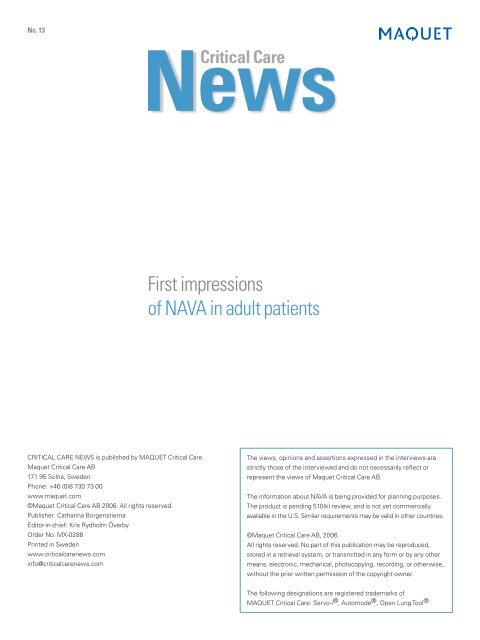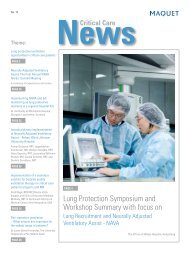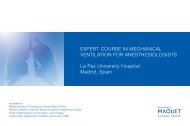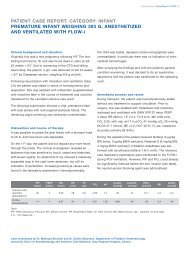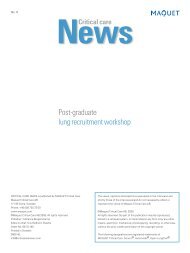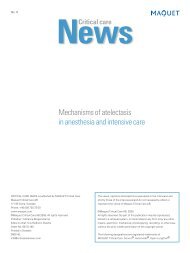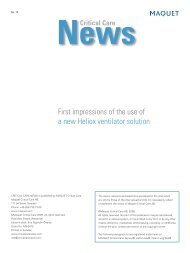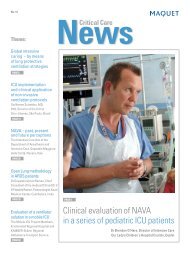First impressions of NAVA in adult patients - Critical Care News
First impressions of NAVA in adult patients - Critical Care News
First impressions of NAVA in adult patients - Critical Care News
You also want an ePaper? Increase the reach of your titles
YUMPU automatically turns print PDFs into web optimized ePapers that Google loves.
NO. 13<br />
<strong>News</strong><br />
<strong>Critical</strong> <strong>Care</strong><br />
<strong>First</strong> <strong>impressions</strong><br />
<strong>of</strong> <strong>NAVA</strong> <strong>in</strong> <strong>adult</strong> <strong>patients</strong><br />
CRITICAL CARE NEWS is published by MAQUET <strong>Critical</strong> <strong>Care</strong>.<br />
Maquet <strong>Critical</strong> <strong>Care</strong> AB<br />
171 95 Solna, Sweden<br />
Phone: +46 (0)8 730 73 00<br />
www.maquet.com<br />
©Maquet <strong>Critical</strong> <strong>Care</strong> AB 2006. All rights reserved.<br />
Publisher: Cathar<strong>in</strong>a Borgenstierna<br />
Editor-<strong>in</strong>-chief: Kris Rydholm Överby<br />
Order No. MX-0288<br />
Pr<strong>in</strong>ted <strong>in</strong> Sweden<br />
www.criticalcarenews.com<br />
<strong>in</strong>fo@criticalcarenews.com<br />
The views, op<strong>in</strong>ions and assertions expressed <strong>in</strong> the <strong>in</strong>terviews are<br />
strictly those <strong>of</strong> the <strong>in</strong>terviewed and do not necessarily reflect or<br />
represent the views <strong>of</strong> Maquet <strong>Critical</strong> <strong>Care</strong> AB.<br />
The <strong>in</strong>formation about <strong>NAVA</strong> is be<strong>in</strong>g provided for plann<strong>in</strong>g purposes.<br />
The product is pend<strong>in</strong>g 510(k) review, and is not yet commercially<br />
available <strong>in</strong> the U.S. Similar requirements may be valid <strong>in</strong> other countries.<br />
©Maquet <strong>Critical</strong> <strong>Care</strong> AB, 2006.<br />
All rights reserved. No part <strong>of</strong> this publication may be reproduced,<br />
stored <strong>in</strong> a retrieval system, or transmitted <strong>in</strong> any form or by any other<br />
means, electronic, mechanical, photocopy<strong>in</strong>g, record<strong>in</strong>g, or otherwise,<br />
without the prior written permission <strong>of</strong> the copyright owner.<br />
The follow<strong>in</strong>g designations are registered trademarks <strong>of</strong><br />
MAQUET <strong>Critical</strong> <strong>Care</strong>: Servo-i ® , Automode ® , Open Lung Tool ®
20 | <strong>Critical</strong> <strong>Care</strong> <strong>News</strong><br />
Dr. Wickerts and patient <strong>in</strong> the ICU.<br />
<strong>First</strong> <strong>impressions</strong><br />
<strong>of</strong> <strong>NAVA</strong> <strong>in</strong> <strong>adult</strong> <strong>patients</strong><br />
Carl-Johan Wickerts is head <strong>of</strong> a busy ICU ward at Danderyd Hospital <strong>in</strong> the city <strong>of</strong> Stockholm. He has<br />
been actively <strong>in</strong>volved <strong>in</strong> respiratory research for a number <strong>of</strong> years, and was <strong>in</strong>trigued by the concept<br />
<strong>of</strong> Neurally Adjusted Ventilatory Assist.<br />
<strong>Critical</strong> <strong>Care</strong> <strong>News</strong> recently met with Dr. Wickerts to discuss his early perceptions and experience <strong>of</strong> <strong>NAVA</strong>.
<strong>Critical</strong> <strong>Care</strong> <strong>News</strong> | 21<br />
Can you describe the size <strong>of</strong> your<br />
department, average number <strong>of</strong> <strong>patients</strong> and<br />
staff here at Danderyd Hospital?<br />
Our <strong>in</strong>tensive care unit here is only about 3<br />
years old, so the environment is quite modern<br />
and up-to-date. We currently have 8 ICU patient<br />
beds, but have recently expanded from 6 to 8<br />
ICU beds. We operate a general ICU, treat<strong>in</strong>g<br />
primarily <strong>adult</strong> <strong>patients</strong>. We have two specialist<br />
physicians on staff on a daily basis, with<br />
additional <strong>in</strong>terns and staff <strong>in</strong> tra<strong>in</strong><strong>in</strong>g. Our total<br />
number <strong>of</strong> ICU personnel here is about 100,<br />
<strong>in</strong>clud<strong>in</strong>g physicians, nurses and licensed practical<br />
nurses. The length <strong>of</strong> stay is approximately 3<br />
days, on average. Most <strong>patients</strong> are here for<br />
just one or two days, and a few <strong>patients</strong> may<br />
be here for much longer periods <strong>of</strong> care.<br />
“We serve a population area<br />
<strong>of</strong> about 475,000 <strong>in</strong> this section<br />
<strong>of</strong> the city with some heavy<br />
<strong>in</strong>dustrial environments, and we<br />
have experienced <strong>in</strong>creas<strong>in</strong>g<br />
numbers <strong>of</strong> COPD <strong>patients</strong> and<br />
<strong>patients</strong> with other respiratory<br />
diseases <strong>in</strong> recent years.”<br />
Which types <strong>of</strong> cl<strong>in</strong>ical situations and patient<br />
categories do you most frequently encounter?<br />
Historically, we had a large <strong>in</strong>fection cl<strong>in</strong>ic<br />
based here for the Stockholm area, so <strong>in</strong> the<br />
past, we had a large number <strong>of</strong> sepsis <strong>patients</strong>.<br />
Currently, we have primarily surgical cases,<br />
comprehensive surgeries, and post-surgical<br />
complications. We have a few trauma cases as<br />
well, but the other ma<strong>in</strong> patient category is<br />
chronic obstructive pulmonary disease<br />
<strong>patients</strong>. We serve a population area <strong>of</strong> about<br />
475,000 <strong>in</strong> this section <strong>of</strong> the city with some<br />
heavy <strong>in</strong>dustrial environments, and we have<br />
experienced <strong>in</strong>creas<strong>in</strong>g numbers <strong>of</strong> COPD<br />
<strong>patients</strong> and <strong>patients</strong> with other respiratory<br />
diseases <strong>in</strong> recent years.<br />
Which ventilation therapies do you normally<br />
use <strong>in</strong> these patient categories?<br />
For the surgical <strong>patients</strong>, they are usually<br />
treated per-operatively with volume controlled<br />
ventilation, and post-operatively, if they rema<strong>in</strong><br />
<strong>in</strong>tubated, we try to go over to pressure<br />
supported modes. We generally never use<br />
Carl-Johan Wickerts, MD, PhD is head <strong>of</strong> the Intensive <strong>Care</strong> department<br />
<strong>of</strong> Danderyd Hospital <strong>in</strong> Stockholm.
22 | <strong>Critical</strong> <strong>Care</strong> <strong>News</strong><br />
Carl-Johan Wickerts has conducted research for many years with<strong>in</strong> the field ventilation therapy.<br />
volume controlled modes <strong>in</strong> the COPD <strong>patients</strong>,<br />
but primarily start out with non-<strong>in</strong>vasive mask<br />
ventilation and pressure supported modes <strong>in</strong><br />
these <strong>patients</strong>, to avoid <strong>in</strong>tubation.<br />
When did you become familiar with the concept<br />
<strong>of</strong> <strong>NAVA</strong> and what led to your <strong>in</strong>terest to<br />
<strong>in</strong>itiate and test this therapy at your hospital?<br />
I first heard about <strong>NAVA</strong> at a lecture by Christer<br />
S<strong>in</strong>derby at an <strong>in</strong>ternational meet<strong>in</strong>g several<br />
years ago. I have followed the development<br />
s<strong>in</strong>ce then, and s<strong>in</strong>ce I personally have been<br />
<strong>in</strong>volved <strong>in</strong> respiratory research and development,<br />
as well as previous development projects for<br />
such th<strong>in</strong>gs as ICU stations. I have a special<br />
<strong>in</strong>terest for new and <strong>in</strong>terest<strong>in</strong>g generations <strong>of</strong><br />
ventilation therapies, particularly those<br />
therapeutic developments that might reduce<br />
response times. But delays <strong>in</strong> trigger<strong>in</strong>g have<br />
always rema<strong>in</strong>ed as a problem area. This is why<br />
<strong>NAVA</strong> as a concept was especially <strong>in</strong>terest<strong>in</strong>g to<br />
me. To have the possibility <strong>of</strong> ventilation without<br />
delay <strong>in</strong> response is an excit<strong>in</strong>g opportunity<br />
What are your first <strong>impressions</strong> <strong>of</strong> <strong>NAVA</strong> so far?<br />
That it works. We had <strong>in</strong>itial concerns, especially<br />
<strong>in</strong> COPD <strong>patients</strong> with very flat diaphragms,<br />
that the signals would have been too weak. The<br />
first two COPD <strong>patients</strong> I treated both had<br />
severe emphysema, and <strong>in</strong> one case the signals<br />
were a bit weaker, but <strong>in</strong> the other very strong<br />
signals were obta<strong>in</strong>ed. We were able to<br />
ventilate both <strong>of</strong> these cases with <strong>NAVA</strong> for<br />
long periods <strong>of</strong> time, up to 18 hours, without<br />
any difficulties. I want to cont<strong>in</strong>ue to get more<br />
experience <strong>of</strong> <strong>NAVA</strong> <strong>in</strong> this particular patient<br />
category. <strong>NAVA</strong> also worked well <strong>in</strong> the other<br />
<strong>patients</strong> we have treated so far, post-op<br />
surgical and acute myocardial <strong>in</strong>farction with<br />
cerebral <strong>in</strong>farction.<br />
What is your practical experience with<br />
plac<strong>in</strong>g and position<strong>in</strong>g the catheter?<br />
Once the catheter is <strong>in</strong> place at the diaphragm,<br />
it has not been difficult to obta<strong>in</strong> a good Edi<br />
signal. However <strong>in</strong> a few cases, we <strong>in</strong>itially<br />
experienced difficulty to place and position the<br />
catheter through the esophagus, and we had a<br />
couple <strong>of</strong> experiences <strong>of</strong> the catheter doubl<strong>in</strong>g<br />
up on itself. Our experiences have contributed to<br />
the development <strong>of</strong> support tools to position and<br />
identify where the best signals can be obta<strong>in</strong>ed.<br />
What is your perception <strong>of</strong> the Edi curve?<br />
It has not been difficult to <strong>in</strong>terpret these<br />
curves, once we have identified that the<br />
catheter is <strong>in</strong> the right place to obta<strong>in</strong> the signal.<br />
The curves have worked very well for us, so far.<br />
What are your current perceptions <strong>of</strong> <strong>NAVA</strong><br />
as a support <strong>in</strong> wean<strong>in</strong>g?<br />
We have been able to extubate most <strong>of</strong> our<br />
<strong>patients</strong> directly from <strong>NAVA</strong>, as a natural step<br />
<strong>in</strong> the wean<strong>in</strong>g process. We have not<br />
experienced any difficulties <strong>in</strong> this respect; our<br />
experience so far is that <strong>NAVA</strong> works very well<br />
from a wean<strong>in</strong>g perspective.
<strong>Critical</strong> <strong>Care</strong> <strong>News</strong> | 23<br />
The Dandeyrd Hospital ICU has been recently constructed, with state-<strong>of</strong>-the-art equipment and w<strong>in</strong>dows reflect<strong>in</strong>g the natural environment<br />
outside <strong>of</strong> the ICU.<br />
CLICK FOR ABSTRACT<br />
Biography<br />
Carl-Johan Wickerts, MD, PhD,<br />
is chief <strong>of</strong> the <strong>in</strong>tensive care unit <strong>of</strong><br />
Danderyd Hospital, Stockholm, Sweden.<br />
He received his medical degree <strong>in</strong> 1978,<br />
and specialized <strong>in</strong> anesthesiology 1982,<br />
with European Diploma <strong>in</strong> Intensive<br />
<strong>Care</strong> Medic<strong>in</strong>e (EDIC) <strong>in</strong> 1994. He<br />
obta<strong>in</strong>ed his doctoral thesis <strong>in</strong> cl<strong>in</strong>ical<br />
physiology at Uppsala University <strong>in</strong> 1991,<br />
and was appo<strong>in</strong>ted Assistant Pr<strong>of</strong>essor<br />
<strong>in</strong> Anesthesiology and Intensive <strong>Care</strong><br />
<strong>in</strong> 1997 at Karol<strong>in</strong>ska Institute,<br />
Stockholm, Sweden.<br />
References<br />
1) Walther SM, Wickerts CJ. Large<br />
regional differences <strong>in</strong> Swedish <strong>in</strong>tensive<br />
care. (Swedish article). Läkartidn<strong>in</strong>gen<br />
2004; 18: 101 (47): 3768, 3771-3773.<br />
2) Almgren B, Wickerts CJ, He<strong>in</strong>onen E,<br />
Hogman M. Side effects <strong>of</strong> endotracheal<br />
suction <strong>in</strong> pressure- and volume-controlled<br />
ventilation. Chest 2004; 125 (3): 1077-1080.<br />
3) Luhr O, Nathorst-Westfelt U, Lund<strong>in</strong> S,<br />
Wickerts CJ, Stiernstrom H, Berggren L,<br />
Aardal S, Johansson LA, Stenqvist O,<br />
Rudberg U, L<strong>in</strong>dh A, B<strong>in</strong>dslev L, Martl<strong>in</strong>g<br />
CR, Hornbaek V, Frostell C. A retrospective<br />
analysis <strong>of</strong> nitric oxide <strong>in</strong>halation <strong>in</strong> <strong>patients</strong><br />
with severe acute lung <strong>in</strong>jury <strong>in</strong> Sweden<br />
and Norway 1991-1994. Acta Anaesthesiol<br />
Scand 1997; 41 (10): 1238-1246.<br />
4) Gardlund B, Sjol<strong>in</strong> J, Nilsson A, Roll M,<br />
Wickerts CJ, Wretl<strong>in</strong>d B. Plasma levels <strong>of</strong><br />
cytok<strong>in</strong>ese <strong>in</strong> primary septic shock <strong>in</strong><br />
humans: correlations with disease severity.<br />
J Infect Dis 1995; 172 (1): 296-301.<br />
5) Wickerts CJ, Blomqvist H, Baehrendtz<br />
S, Kl<strong>in</strong>gstedt C, Hedenstierna G, Frostell<br />
C. Cl<strong>in</strong>ical application <strong>of</strong> differential<br />
ventilation with selective positive endexpiratory<br />
pressure <strong>in</strong> <strong>adult</strong> respiratory<br />
distress syndrome. Acta Anaesthesiol<br />
Scand. 1995; 39 (3): 307-311.<br />
6) Hedenstierna G, Frostell C, Wickerts C-<br />
J. Atelectasis and oedema <strong>of</strong> the lung.<br />
Current Practice <strong>in</strong> <strong>Critical</strong> Illness. Chapman<br />
& Hall Medical 1997. ISBN 0412 618 001.


